Abstract
Nowadays, Wireless Mesh Networks (WMNs) are widely deployed in communication areas due to their ease of implementation, dynamic self-organization, and cost-effectiveness. The design of routing protocols is critical for ensuring the performance and reliability of WMNs. Although there have been numerous experimental works on WMNs in the past decade, only a few of them have been tested in real-world scenarios. This article presents a comparative analysis of three proactive routing protocols, OLSR, BATMAN, and Babel, using Raspberry Pi 4 devices. The evaluation, conducted at Al-Farabi Kazakh National University, covers both indoor and outdoor scenarios, focusing on key metrics such as bandwidth, Packet Delivery Ratio (PDR), and jitter. In outdoor scenarios, OLSR achieved the highest bandwidth at 2.9 Mbps, while BATMAN and Babel lagged. Indoor tests revealed that Babel initially outperformed with the highest bandwidth of 57.19 Mb/s but suffered from scalability issues, while BATMAN and OLSR exhibited significant declines in performance as network size increased. For PDR, BATMAN performed best with a decline from 100% to 42.8%, followed by OLSR with a moderate drop, and Babel with the greatest decrease. For jitter, OLSR showed the most stable performance, increasing from 0.281 ms to 2.58 ms at eleven nodes, BATMAN exhibited moderate increases, and Babel experienced the highest rise.
1. Introduction
Wireless Mesh Networks (WMNs) are an innovative communication technology that has experienced rapid global development over the last decade. This accelerated deployment is due to its key advantages such as easy implementation, dynamic self-organization, self-configuration, a self-adaptive nature, and cost-effectiveness. Furthermore, WMNs have a variety of applications, like broadband home networking, education, healthcare, industrial automation, military operations, and disaster management. A WMN is organized into three layers: Mesh Routers (MRs), Mesh Gateways (MGs), and Mesh Clients (MCs). Mesh Clients (MCs) encompass desktop computers, mobile devices, laptops, and Pocket PCs that connect to the internet via Mesh Routers (MRs). MRs serve as intermediaries, which relay traffic to Mesh Gateways (MGs) that are directly linked to the internet infrastructure. The architecture of a WMN can be seen in Figure 1 [1,2,3].
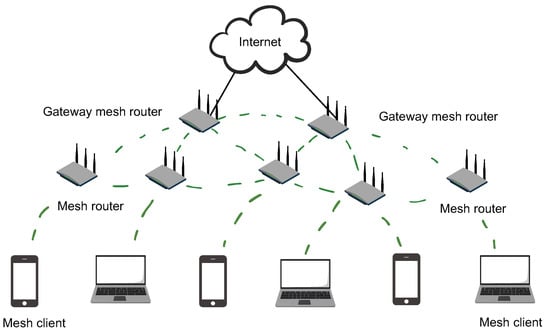
Figure 1.
WMN architecture.
The design of routing protocols is crucial for ensuring the performance and reliability of WMNs. The routing protocol plays a significant role in determining how data packets are forwarded between nodes in WMNs. If the routing protocol is not properly designed, WMNs can experience various issues, such as high latency, packet loss, low throughput, and network congestion, which can degrade the overall performance of the network [4,5,6]. While many routing protocols for WMNs have been proposed in the last decade, relatively few of them have been tested under real-world experimental conditions [7,8,9,10,11,12,13,14,15,16,17,18]. In [9], the authors implement and develop a WMN testbed utilizing layer 2 routing protocols, specifically BATMAN-adv and HWMN, to analyze their performance and compare their efficiency in real-time scenarios, highlighting the advantages of reduced processing overhead and the capability to support higher-layer protocols. The authors of [10] describe the implementation of a testbed for WMNs and analyze the performance of the OLSR protocol in an indoor environment with mobile mesh nodes and evaluating metrics such as throughput, Packet Delivery Ratio (PDR), hop count, delay, and jitter. The authors of [12] conducted real-world experiments, but the execution time of the experiment was insufficient, resulting in rough data. In [13], the authors compare the Optimized Link State Routing (OLSR) and Better Approach to Mobile Ad hoc Networking (BATMAN) routing protocols in a WMN, utilizing a testbed comprising six Raspberry Pi 4 network nodes. In [14], the authors represent the implementation of a testbed for WMNs utilizing Raspbian OS and analyze only the performance of the OLSR protocol in an indoor scenario. In [15], the authors evaluate a testbed for two routing protocols, including OLSR and Babel, using multiple Raspberry Pi 4 devices to assess the impact of multi-hops on bandwidth and delay.
The aim of this article is to assess the performance of the OLSR, BATMAN, and Babel proactive routing protocols in a WMN using 11 Raspberry Pi 4 devices. By analyzing these protocols, we provide insights into their relative strengths and weaknesses in both indoor and outdoor static scenarios. The evaluation was conducted at Al-Farabi Kazakh National University, with indoor tests lasting 24 h and outdoor tests lasting 1000 s. A key distinction of our work from other articles is the extended duration of the experiments and the larger number of Raspberry Pi nodes used. In recent articles, the maximum test duration observed was 400 s [7,8,9,10,11,12,13,14,15,16,17,18], which we consider insufficient for a thorough evaluation of wireless network performance. To assess the effectiveness of these routing algorithms, we considered key metrics including bandwidth, jitter, and Packet Delivery Ratio (PDR). These metrics are crucial for evaluating routing protocols in WMNs and help identify their strengths and limitations.
The rest of this paper is organized as follows. Section 2 provides an overview of the selected routing protocols for WMNs compared in this article. In Section 3, the testbed is described in detail, covering the Raspberry Pi 4 setup, experimental settings and parameters, system testing, and scenarios. Section 4 presents and discusses the results. Section 5 concludes the article.
2. Selected Routing Protocols
The main goal of routing in WMNs is to establish the most efficient path for the transmission of data packets between source and destination nodes within the network. Routing protocols in WMNs may be classified into three categories, proactive, reactive, and hybrid, according to their packet forwarding approaches (Figure 2) [16].
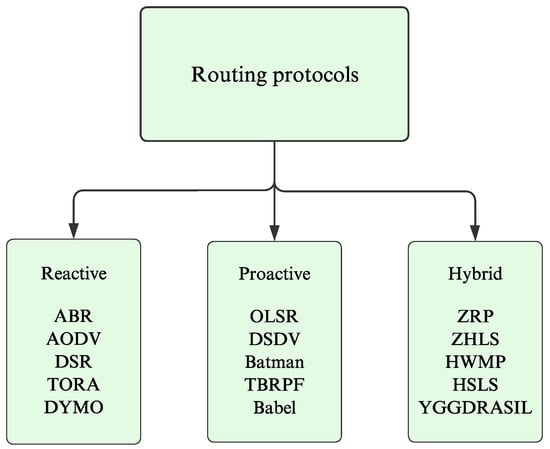
Figure 2.
Sorting of WMN routing protocols.
Proactive routing protocols, or table-driven systems, create routes to all accessible destination nodes, irrespective of their necessity for data transfer. They constantly estimate the pathways to all nodes that can be reached and provide consistent and up-to-date routing information. Thus, the primary advantage of proactive protocols lies in their ability to enable nodes to swiftly acquire routing information and establish communication pathways with minimal delay [17,18].
Reactive routing protocols, also known as on-demand methods, establish routes only when required. When the source node needs a route to a destination node, the route discovery process is activated. This procedure persists until a route is discovered or until all possible paths have been assessed and deemed unavailable. In mobile networks, active routes may be disrupted due to node mobility. However, in WMNs, node mobility is relatively limited, enhancing the scalability of reactive routing protocols [19,20].
Hybrid routing protocols combine the strengths of both proactive and reactive approaches, addressing their respective limitations to determine optimal routes while minimizing management overhead. These protocols deploy different routing strategies in various segments of the WMN architecture. Reactive protocols are employed within the ad hoc network regions, whereas proactive protocols are utilized in the wireless backbone, facilitating efficient and effective routing processes [21,22].
In this article, we consider three proactive routing protocols—OLSR, BATMAN, and Babel—due to their prevalent use in the recent literature [13,14,15,16,17,18] and their broad application across diverse communication scenarios [23,24,25,26,27]. These protocols have been extensively studied [17,18,23,24,25] for their effectiveness and adaptability in various network environments, making them ideal candidates for evaluating performance in a WMN.
OLSR is an optimized version of the standard channel state routing algorithm, and it has two versions. Version 1 (OLSRv1) was presented by the French National Institute for Research in Computer Science and Management (INRIA). Version 2 (OLSRv2) is an updated version of OLSR1, and it retains the same mechanism, but with some improvements [28,29,30].
OLSRv1 is a proactive routing protocol, which continuously updates and maintains a network topology map to enable efficient data transfer between network nodes. In this protocol, each node within the network broadcasts its current link state information to all other nodes. The OLSRv1 algorithm uses two types of control massages, such as HELLO and TOPOLOGY CONTROL (TC). Periodically, TC messages are transmitted only by MPR hosts. Multipoint relays (MPRs) are an essential aspect of the OLSRv1 protocol to minimize broadcast transmission. Each node chooses a set of MPRs from its neighbors that has a one hop bidirectional link to all other nodes that are two hops away. This set may vary depending on the time specified by the selecting nodes in their HELLO messages. When a node transmits a message, all its neighboring nodes receive it. Only MPRs that receive the message for the first time will propagate it further. As a result, the amount of flooding overhead can be decreased. The OLSRRv1 offers an advantage over other proactive protocols by broadcasting its link state information instead of routing tables. This allows messages to be delivered in any order due to the use of sequence numbers. OLSRv1 is particularly well suited for large and dense networks [31,32,33].
OLSRv2 is a proactive routing protocol that builds upon the core algorithms of OLSR while introducing new features, such as routing multipoint relay (MPR), flexible link metrics, and extensible message formats. It consists of three primary components: neighborhood discovery, MPR selection, and topology establishment. OLSRv2 utilizes two types of control messages: HELLO and TOPOLOGY CONTROL (TC). The neighborhood discovery process enables nodes to identify their one-hop neighbors within radio range. During this process, HELLO messages convey link status information, indicating whether a link is symmetric, asymmetric, or a multipoint relay. Neighborhood discovery is complete once a bidirectional link between two nodes is established. OLSRv2 also employs two methods for MPR selection, flooding MPR selection and routing MPR selection, with flooding MPR selection being important for managing traffic forwarding across the network. Flooding MPR selection is used to reduce control traffic in the network and boost the efficiency of the routing protocol. To form an MPR set, each node is required to select potential candidates from its bidirectional neighbors. Only those nodes that belong to the MPR set are allowed to forward control traffic. Routing MPR selection is similar to flooding MPR selection, but its purpose is to minimize the network topology. Nodes that are not included in the MPR routing set do not need to forward information about the link state. The process of establishing the network topology relies on the dissemination of link state information [34,35,36,37].
The BATMAN protocol was developed to overcome the shortcomings of OLSR, specifically in networks with unreliable links. It functions by having each participating node maintain a record of distances to other nodes within the network, with routing decisions made based on the shortest distance. Instead of requiring comprehensive global topology information, each node retains only limited data regarding the optimal next hop to reach other nodes. This eliminates the need for global awareness of local topological changes [38,39].
BATMAN represents an innovative and distinct approach to routing. Although it constructs routing tables and is considered a proactive routing protocol, it adopts a biologically inspired method similar to AntHocNET. Unlike traditional link state or distance-vector protocols, BATMAN does not aim to explicitly discover or calculate routes. Instead, it focuses on identifying which neighboring node provides the most optimal path to each originator [40,41].
In BATMAN, routing information is not directly exchanged. Instead, each node broadcasts Originator Messages (OGMs) at regular intervals, typically every second. When neighboring nodes receive these OGMs, they re-broadcast them. The route selection for a specific destination is determined based on the node from which the greatest number of OGMs for that destination has been received. The number of OGMs that can be processed is limited by a dynamically moving window, which restricts the historical data used to describe a route. BATMAN’s scalability relies on packet loss; OGMs are transmitted as unreliable UDP packets, similar to other algorithms. Continuous OGM broadcasts would congest the network without packet loss. Consequently, BATMAN’s scalability is dependent on packet loss, making it unsuitable for reliable wired networks [42,43,44].
Babel, a recent mesh routing protocol defined by IETF RFC 6126, demonstrates performance that is twice as fast as BATMAN and effectively handles traffic through its efficient path selection mechanism. Similar to HWMP, Babel utilizes comparable route cost metrics, yet it does not rely on a fixed routing strategy. It is proactive but also includes reactive features and is implemented on Linux and OpenWrt. Based on the Bellman–Ford algorithm, Babel aims to prevent routing pathologies such as loops and black holes using a feasibility condition and sequence numbers for routing updates. A routing update is feasible if its metric is smaller than previously advertised routes. Sequence numbers, generated by the destination node, ensure comparable metrics [45,46].
Babel discovers neighbors through Hello messages, sent to a multicast address every four seconds, estimating link reception cost (rxcost). I Heard You (IHU) messages, sent every 12 s, determine link bidirectionality and share rxcost without ARP exchanges. Nodes share routing tables in route update messages to discover distant nodes. Updates are sent periodically to a multicast address, with unscheduled updates triggered by significant topology changes, reducing the need for frequent updates (default every 16 s). Feasible updates are used to compute accumulated metrics by adding the link cost [47,48,49].
3. Testbed Description
3.1. Raspberry Pi 4
The Raspberry Pi 4 is an affordable, compact single-board computer designed by the Raspberry Pi Foundation to promote and enhance education in computer science. Since its initial release in 2012, Raspberry Pi has gained widespread popularity across various applications due to its versatility, affordability, and compatibility with multiple operating systems, primarily Linux-based distributions and Ubuntu. Key features of Raspberry Pi include its compact size, enhanced portability, and economic price point. Raspberry Pi has evolved through multiple iterations, including Raspberry Pi 1, 2, 3, and 4, each offering varying levels of performance and features. A notable characteristic of Raspberry Pi is its General Purpose Input/Output (GPIO) pins, which facilitate the connection and control of various hardware components. Raspberry Pi is equipped with diverse connectivity options, such as USB ports, HDMI output, Ethernet, and, in more recent models, Wi-Fi and Bluetooth.
In this article, we utilize Raspberry Pi 4 Model B, a fourth-generation device powered by a Broadcom BCM2711 SoC and a 1.8 GHz 64-bit Quad-Core ARMv8 CPU. The device is equipped with 8 GB of LPDDR4-3200 SDRAM, providing robust performance for various applications. Its networking capabilities include dual-band 2.4 GHz and 5 GHz IEEE 802.11ac wireless, along with Gigabit Ethernet, and Bluetooth 5.0 with BLE. Storage is supported via a microSD card slot. Raspberry Pi 4 Model B also features a 40-pin GPIO header and multiple ports, including two micro-HDMI ports (supporting up to 4Kp60 resolution), a two-lane MIPI DSI display port, a two-lane MIPI CSI camera port, and a four-pole stereo audio/composite video port [50,51,52].
Figure 3a,b demonstrate the internal and external appearance of the Raspberry Pi 4 Model B node used in the experiment.
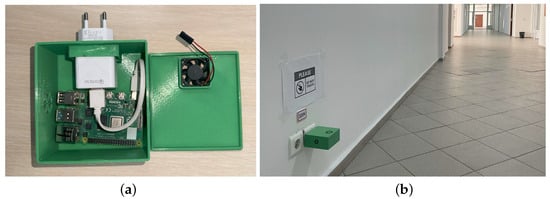
Figure 3.
Raspberry Pi 4 Model B node (a) internal appearance and (b) external appearance.
3.2. Experimental Settings and Parameters
The parameters for the outdoor and indoor experiments, presented in Table 1, were both established and conducted on the territory of Kazakh National University (KazNU). Data were collected for three metrics: bandwidth, PDR, and jitter.

Table 1.
Experimental parameters.
The data were collected using Iperf, a network performance testing tool originally developed by NLANR/DAST. Iperf is designed to measure TCP and UDP bandwidth and allows users to adjust various parameters and UDP settings for performance evaluation. Our experiment utilized one iperf3 client and one iperf3 server.
3.3. System Testing
Three different metrics were observed to investigate the performance of each routing protocol. The first investigation observed the optimal bandwidth of each protocol in an outdoor scenario and in an indoor scenario. The bandwidth was measured using iperf3 with UDP packets over a period of 86,400 s for indoor and 1000 s for outdoor testbeds. The second and third investigation examined other performance characteristics of the protocols, such as jitter and PDR for the indoor testbed.
3.4. Scenarios
The evaluation of the routing protocols was conducted in both indoor and outdoor static scenarios, enabling a comprehensive analysis of WMN performance across different environmental conditions. In the indoor scenario depicted in Figure 4, the number of WMN nodes was increased from two to eleven Raspberry Pi 4 nodes, distributed across several offices within the university.
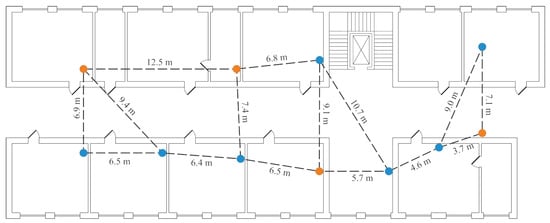
Figure 4.
An indoor WMN testbed featuring orange nodes as endpoints and blue nodes as routers.
In Figure 4, the orange nodes represent the endpoints to which the data packets were routed, while the blue nodes signify the routers within the network responsible for transporting the data from the sender to the receiver. These nodes were located on the two most remote points of the network from each other, with an intermediate ‘mesh’ network between them.
The outdoor scenario, represented in Figure 5, involved a WMN consisting of eleven Raspberry Pi 4 nodes allocated along the roads throughout the university campus.
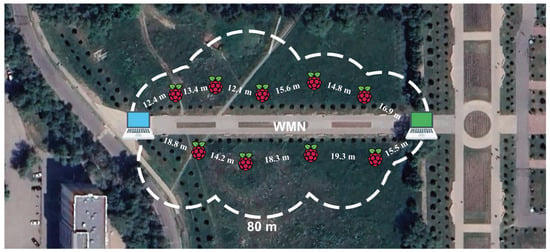
Figure 5.
Outdoor WMN testbed.
In Figure 5, the laptop nodes represent the endpoints to which data packets were routed, while the Raspberry Pi 4 nodes function as the routers within the network, responsible for transporting data from the sender to the receiver. These nodes were situated at the two most distant points within the network, with an intermediate mesh network positioned between them. The experimental development scenarios consider the impact of nearby wireless systems and Wi-Fi access points on signal strength.
4. Experimental Results
4.1. Bandwidth Testing
Bandwidth is the maximum data transfer rate or available capacity of a physical communication link. Figure 6 shows the value of bandwidth for three routing protocols in the outdoor scenario.
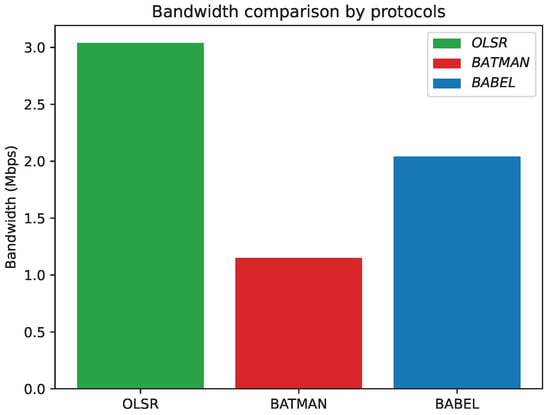
Figure 6.
Bandwidth (outdoor testbed).
Figure 6 demonstrates that OLSR outperformed the other two routing protocols, reaching 2.9 Mbps. This demonstrates the protocol’s capability to handle routing efficiently in a dynamically changing network environment, which is crucial for maintaining reliability in WMNs. BABEL achieved the highest bandwidth at 2 Mbps, followed by BATMAN recording the lowest at 1.1 Mbps.
Figure 7 presents the value of bandwidth for three routing protocols in the indoor scenario, where the number of nodes varied from 2 to 11, enabling an evaluation of each protocol’s scalability based on network size.
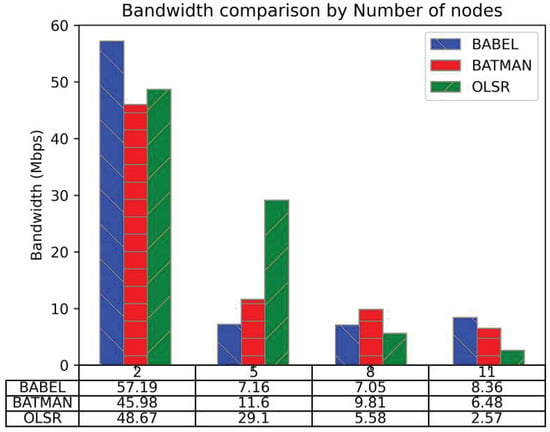
Figure 7.
Bandwidth (indoor testbed).
As seen in Figure 7, the Babel protocol initially demonstrated the highest bandwidth of 57.19 Mb/s with two nodes, but its performance declined to 7.16 Mb/s with five nodes and to 7.05 Mb/s with eight nodes, before improving slightly to 8.36 Mb/s with eleven nodes, indicating generally better performance with more nodes. The BATMAN protocol exhibited an initial bandwidth of 45.98 Mb/s at two nodes, which declined to 11.6 Mb/s at five nodes, to 9.81 Mb/s at eight nodes, and further to 6.48 Mb/s at eleven nodes. The OLSR protocol showed an initial bandwidth of 48.67 Mb/s at two nodes, reaching 29.1 Mb/s at five nodes before dropping to 5.58 Mb/s at eight nodes and to 2.57 Mb/s at eleven nodes, suggesting a significant increase in network load as the network size expands. Figure 6 shows that the Babel protocol generally outperforms the other two routing protocols, BATMAN and OLSR.
4.2. PDR Testing
The PDR is the ratio of successfully delivered data packets to the total packets transmitted within a network. The observation of the PDR for Babel, BATMAN, and OLSR when the number of nodes varied from 2 to 11 can be seen in Figure 8.
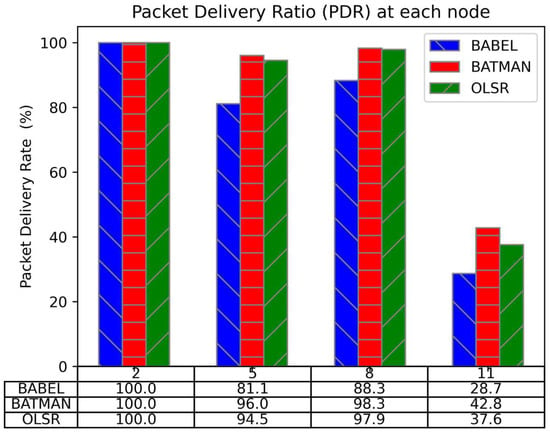
Figure 8.
Packet Delivery Ratio.
As seen in Figure 8, BATMAN exhibits the best performance, with a PDR of 100% at two nodes, a slight decrease to 96% at five nodes, an improvement to 98.3% at eight nodes, and a drop to 42.8% at eleven nodes. OLSR follows, starting at 100% and experiencing a less pronounced decline, while Babel shows the greatest decline in the PDR, starting at 100% and dropping to 28.7% at eleven nodes, indicating the highest sensitivity to network size.
4.3. Jitter Testing
Jitter measures the variability in packet arrival times, reflecting delays and fluctuations in data transmission. Figure 9 illustrates the jitter observed across varying numbers of nodes (2, 5, 8, and 11 nodes) for three different routing protocols: Babel, BATMAN, and OLSR.
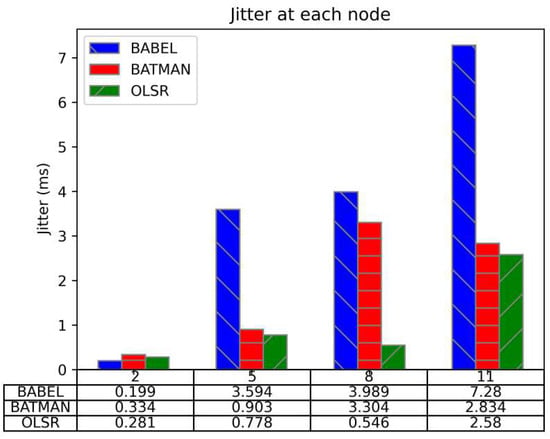
Figure 9.
Jitter of 3 routing protocols.
In Figure 9, OLSR starts with a jitter of 0.281 ms and increases to 2.58 ms at eleven nodes, showing relatively stable performance. BATMAN begins with 0.334 ms and rises to 2.834 ms, indicating moderate increases in delays. Babel starts with the lowest jitter of 0.199 ms but experiences the largest increase, reaching 7.28 ms at eleven nodes, reflecting the highest sensitivity to network size.
5. Conclusions
This article evaluated the performance of the OLSR, BATMAN, and Babel proactive routing protocols in a Wireless Mesh Network (WMN) using 11 Raspberry Pi 4 devices, with tests conducted at Al-Farabi Kazakh National University. The assessment covered bandwidth, PDR, and jitter in both indoor and outdoor scenarios.
In outdoor testing, OLSR demonstrated the highest bandwidth of 2.9 Mbps, outperforming Babel and BATMAN, which achieved 2 Mbps and 1.1 Mbps, respectively. For indoor testing, Babel initially offered the highest bandwidth of 57.19 Mb/s with two nodes but showed a significant decline with increasing nodes, whereas BATMAN and OLSR also experienced reductions, with Babel generally outperforming the other protocols at larger node counts.
Regarding PDR, BATMAN achieved the best performance with minimal decline, from 100% at two nodes to 42.8% at eleven nodes. OLSR displayed a more stable performance compared to Babel, which experienced the greatest decline, highlighting its sensitivity to network size.
In jitter testing, OLSR exhibited the most stable performance, with jitter increasing from 0.281 ms to 2.58 ms as nodes increased. BATMAN showed moderate increases in jitter, from 0.334 ms to 2.834 ms, while Babel, starting with the lowest jitter of 0.199 ms, experienced the most substantial rise, reaching 7.28 ms, indicating the highest sensitivity to network size.
Overall, OLSR proved to be the most stable in terms of jitter, BATMAN excelled in PDR, and Babel, despite its initial bandwidth advantage, displayed significant sensitivity to WMN size. This comprehensive analysis provides valuable insights into the relative strengths and weaknesses of these routing protocols in WMNs.
Author Contributions
Conceptualization, N.U. and A.B.; methodology, A.B.; software, A.A.; validation, A.A. and A.B.; formal analysis, N.U.; investigation, A.B.; resources, S.T.; data curation, S.A.; writing—original draft preparation, S.T. and D.T.; writing—review and editing, D.T.; visualization, A.A.; supervision, X.T.; project administration, N.U. All authors have read and agreed to the published version of the manuscript.
Funding
This research was funded by the Committee of Science of the Ministry of Science and Higher Education of the Republic of Kazakhstan under grant AP19674715.
Data Availability Statement
Data is contained within the article.
Conflicts of Interest
The authors declare no conflicts of interest.
References
- Seyedzadegan, M.; Othman, M.; Ali, B.M.; Subramaniam, S. Wireless mesh networks: WMN overview, WMN architecture. In Proceedings of the International Conference on Communication Engineering and Networks IPCSIT, San Francisco, CA, USA, 19–21 October 2011; Volume 19, p. 2. [Google Scholar]
- Pathan, A.S.K. Security of Self-Organizing Networks: MANET, WSN, WMN, VANET; CRC Press: Boca Raton, FL, USA, 2016. [Google Scholar]
- Sakamoto, S.; Lala, A.; Oda, T.; Kolici, V.; Barolli, L.; Xhafa, F. Application of WMN-SA simulation system for node placement in wireless mesh networks: A case study for a realistic scenario. Int. J. Mob. Comput. Multimed. Commun. (IJMCMC) 2014, 6, 13–21. [Google Scholar] [CrossRef]
- Matsuo, K.; Sakamoto, S.; Oda, T.; Barolli, A.; Ikeda, M.; Barolli, L. Performance analysis of WMNs by WMN-GA simulation system for two WMN architectures and different TCP congestion-avoidance algorithms and client distributions. Int. J. Commun. Netw. Distrib. Syst. 2018, 20, 335–351. [Google Scholar] [CrossRef]
- Turlykozhaeyva, D.; Ussipov, N.; Baigaliyeva, A.; Temesheva, S.; Bolysbay, A.; Abrakhmatova, G.; Akhtanov, S. Routing metric and protocol for wireless mesh network based on information entropy theory. Eurasian Phys. Tech. J. 2023, 20, 90–98. [Google Scholar] [CrossRef]
- Gilani, S.S.A.; Qayyum, A.; Rais, R.N.B.; Bano, M. SDNMesh: An SDN based routing architecture for wireless mesh networks. IEEE Access 2020, 8, 136769–136781. [Google Scholar] [CrossRef]
- Oda, T.; Barolli, A.; Sakamoto, S.; Barolli, L.; Ikeda, M.; Uchida, K. Implementation and experimental results of a WMN testbed in indoor environment considering LoS scenario. In Proceedings of the 2015 IEEE 29th International Conference on Advanced Information Networking and Applications, Gwangiu, Republic of Korea, 24–27 March 2015; pp. 37–42. [Google Scholar]
- Oda, T.; Barolli, L. Experimental results of a Raspberry Pi based WMN testbed considering CPU frequency. In Proceedings of the 2016 IEEE 30th International Conference on Advanced Information Networking and Applications (AINA), Crans-Montana, Switzerland, 23–25 March 2016; pp. 981–986. [Google Scholar]
- Singh, M.S.; Talasila, V. A practical evaluation for routing performance of BATMAN-ADV and HWMN in a Wireless Mesh Network test-bed. In Proceedings of the 2015 international conference on smart sensors and systems (IC-SSS), Bangalore, India, 21–23 December 2015; pp. 1–6. [Google Scholar]
- Oda, T.; Elmazi, D.; Yamada, M.; Obukata, R.; Barolli, L.; Takizawa, M. Experimental results of a Raspberry Pi based WMN testbed in indoor environment: A comparison study of LoS and NLoS scenarios. In Proceedings of the 2016 19th International Conference on Network-Based Information Systems (NBiS), Ostrava, Czech Republic, 7–9 September 2016; pp. 9–14. [Google Scholar]
- Pakzad, F.; Portmann, M.; Turletti, T.; Parmentelat, T.; Mahfoudi, M.N.; Dabbous, W. R2Lab testbed evaluation for wireless mesh network experiments. In Proceedings of the 2018 28th International Telecommunication Networks and Applications Conference (ITNAC), Sydney, Australia, 21–23 November 2018; pp. 1–6. [Google Scholar]
- Bansal, D.; Sofat, S. Deployment and evaluation of IEEE 802.11 based wireless mesh networks in campus environment. In Proceedings of the 4th ACM Workshop on Networked Systems for Developing Regions, San Francisco, CA, USA, 15 June 2010; pp. 1–2. [Google Scholar]
- Baharuddin, M.; Panggalo, S.; Gufran, M. Performance of routing protocol OLSR and BATMAN in multi-hop and mesh ad hoc network on raspberry pi. In Proceedings of the IOP Conference Series: Materials Science and Engineering; IOP Publishing: Bristol, UK, 2020; Volume 875, p. 012046. [Google Scholar]
- Oda, T.; Matsuo, K.; Barolli, L.; Ikeda, M.; Takizawa, M. Performance Evaluation of a WMN Testbed in Indoor Environment Considering Mobile Mesh Node Scenario. In Proceedings of the 2015 18th International Conference on Network-Based Information Systems, Taipei, Taiwan, 2–4 September 2015; pp. 93–98. [Google Scholar]
- Sati, S.; El-Bareg, A. Manet testbed using raspberry pis. IJ Wirel. Microw. Technol. 2018, 2, 52–63. [Google Scholar] [CrossRef]
- Gupta, A.K.; Sadawarti, H.; Verma, A.K. Review of various routing protocols for MANETs. Int. J. Inf. Electron. Eng. 2011, 1, 251. [Google Scholar] [CrossRef][Green Version]
- Shruthi, S. Proactive routing protocols for a MANET—A review. In Proceedings of the 2017 International Conference on I-SMAC (IoT in Social, Mobile, Analytics and Cloud)(I-SMAC), Palladam, India, 10–11 February 2017; pp. 821–827. [Google Scholar]
- Mohseni, S.; Hassan, R.; Patel, A.; Razali, R. Comparative review study of reactive and proactive routing protocols in MANETs. In Proceedings of the 4th IEEE International Conference on Digital Ecosystems and Technologies, Dubai, United Arab Emirates, 13–16 April 2010; pp. 304–309. [Google Scholar]
- Shrivastava, P.K.; Vishwamitra, L. Comparative analysis of proactive and reactive routing protocols in VANET environment. Meas. Sens. 2021, 16, 100051. [Google Scholar] [CrossRef]
- Kaur, H.; Sahni, V.; Bala, M. A survey of reactive, proactive and hybrid routing protocols in MANET: A review. Network 2013, 4, 498–500. [Google Scholar]
- Chai, Y.; Shi, W.; Shi, T.; Yang, X. An efficient cooperative hybrid routing protocol for hybrid wireless mesh networks. Wirel. Netw. 2017, 23, 1387–1399. [Google Scholar] [CrossRef]
- Cheng, H.; Cao, J. A design framework and taxonomy for hybrid routing protocols in mobile ad hoc networks. IEEE Commun. Surv. Tutor. 2008, 10, 62–73. [Google Scholar] [CrossRef]
- Singh, A.; Kumar, S.; Walia, S.S. Routing protocols for WMNS: A survey. Int. J. Adv. Res. Comput. Sci. Softw. Eng 2017, 11, 445–495. [Google Scholar] [CrossRef]
- Turlykozhaeyva, D.; Akhtanov, S.; Baigalyieva, A.; Temesheva, S.; Zhexebay, D.; Zaidyn, M.; Ussipov, N.; Skabylov, A. Evaluating routing algorithms across different wireless mesh network topologies using ns-3 simulator. Eurasian Phys. Technol. J. 2024, 21, 70–82. [Google Scholar] [CrossRef]
- Samo, S.D.; Fendji, J.L.E. Evaluation of Energy Consumption of Proactive, Reactive, and Hybrid Routing Protocols in Wireless Mesh Networks Using 802.11 Standards. J. Comput. Commun. 2018, 6, 1. [Google Scholar] [CrossRef]
- Singh, M. Node-to-Node Approaching in Wireless Mesh Connectivity; Springer: Berlin/Heidelberg, Germany, 2019; pp. 15–20. [Google Scholar]
- Jubair, M.A.; Khaleefah, S.H.; Budiyono, A.; Mostafa, S.A.; Mustapha, A. Performance evaluation of AODV and OLSR routing protocols in MANET environment. Int. J. Adv. Sci. Eng. Inf. Technol. 2018, 8, 1277–1283. [Google Scholar] [CrossRef]
- Jabbar, W.A.; Ismail, M.; Nordin, R. On the performance of the current MANET routing protocols for VoIP, HTTP, and FTP applications. J. Comput. Netw. Commun. 2014, 2014, 154983. [Google Scholar] [CrossRef]
- Herberg, U. Performance evaluation of using a dynamic shortest path algorithm in OLSRv2. In Proceedings of the 2010 8th Annual Communication Networks and Services Research Conference, Montreal, QC, Canada, 11–14 May 2010; pp. 376–380. [Google Scholar]
- Lakrami, F.; Elkamoun, N.; El Kamili, M. A survey on QoS for OLSR routing protocol in MANETs. In Advances in Ubiquitous Networking: Proceedings of the UNet’15 1; Springer: Berlin/Heidelberg, Germany, 2016; pp. 287–300. [Google Scholar]
- Shcherba, E.V.; Litvinov, G.A.; Shcherba, M.V. A novel reputation model for trusted path selection in the OLSR routing protocol. In Proceedings of the 2019 International Conference on Information Science and Communications Technologies (ICISCT), Karachi, Pakistan, 9–10 March 2019; pp. 1–5. [Google Scholar]
- Jabbar, W.A.; Saad, W.K.; Ismail, M. MEQSA-OLSRv2: A multicriteria-based hybrid multipath protocol for energy-efficient and QoS-aware data routing in MANET-WSN convergence scenarios of IoT. IEEE Access 2018, 6, 76546–76572. [Google Scholar] [CrossRef]
- Jain, R.; Kashyap, I. An QoS aware link defined OLSR (LD-OLSR) routing protocol for MANETs. Wirel. Pers. Commun. 2019, 108, 1745–1758. [Google Scholar] [CrossRef]
- Barz, C.; Niewiejska, J.; Rogge, H. NHDP and OLSRv2 for community networks. In Proceedings of the 2013 IEEE 9th International Conference on Wireless and Mobile Computing, Networking and Communications (WiMob), Lyon, France, 7–9 October 2013; pp. 96–102. [Google Scholar]
- Yavuz, U.; Dael, F.A.; Jabbar, W.A.J.S.A. Performance evaluation of DYMO and OLSRv2 routing protocols in VANET. Int. J. Integr. Eng. 2020, 12, 50–58. [Google Scholar]
- Clausen, T.; Herberg, U. Router and link admittance control in the optimized link state routing protocol version 2 (olsrv2). In Proceedings of the 2010 Fourth International Conference on Network and System Security, Melbourne, VIC, Australia, 1–3 September 2010; pp. 40–46. [Google Scholar]
- Vara, M.I.; Campo, C. Cross-layer service discovery mechanism for OLSRv2 mobile ad hoc networks. Sensors 2015, 15, 17621–17648. [Google Scholar] [CrossRef]
- Sanchez-Iborra, R.; Cano, M.D.; Garcia-Haro, J. Performance evaluation of BATMAN routing protocol for VoIP services: A QoE perspective. IEEE Trans. Wirel. Commun. 2014, 13, 4947–4958. [Google Scholar] [CrossRef]
- Kiran, K.; Kaushik, N.; Sharath, S.; Shenoy, P.D.; Venugopal, K.; Prabhu, V.T. Experimental evaluation of BATMAN and BATMAN-Adv routing protocols in a mobile testbed. In Proceedings of the TENCON 2018-2018 IEEE Region 10 Conference, Jeju, Republic of Korea, 28–31 October 2018; pp. 1538–1543. [Google Scholar]
- Mamatas, L.; Demiroglou, V.; Kalafatidis, S.; Skaperas, S.; Tsaoussidis, V. Protocol-adaptive strategies for wireless mesh smart city networks. IEEE Netw. 2023, 37, 136–143. [Google Scholar] [CrossRef]
- Sliwa, B.; Falten, S.; Wietfeld, C. Performance evaluation and optimization of batman v routing for aerial and ground-based mobile ad-hoc networks. In Proceedings of the 2019 IEEE 89th Vehicular Technology Conference (vtc2019-Spring), Kuala Lumpur, Malaysia, 28 April–1 May 2019; pp. 1–7. [Google Scholar]
- Liu, L.; Liu, J.; Qian, H.; Zhu, J. Performance evaluation of BATMAN-adv wireless mesh network routing algorithms. In Proceedings of the 2018 5th IEEE International Conference on Cyber Security and Cloud Computing (CSCloud)/2018 4th IEEE International Conference on Edge Computing and Scalable Cloud (EdgeCom), Shanghai, China, 22–24 June 2018; pp. 122–127. [Google Scholar]
- Reineri, M.; Rubino, R.; Casetti, C.; Chiasserini, C.F. Experimental performance assessment of WMN routing protocols with mobile nodes. In Proceedings of the 2011 7th International Wireless Communications and Mobile Computing Conference, Istanbul, Turkey, 4–8 July 2011; pp. 1010–1015. [Google Scholar]
- Cigno, R.; Furlan, D. Improving BATMAN Routing Stability and Performance. Ph.D. Thesis, University of Trento, Trento, Italy, 2011. [Google Scholar]
- Seither, D.; König, A.; Hollick, M. Routing performance of Wireless Mesh Networks: A practical evaluation of BATMAN advanced. In Proceedings of the 2011 IEEE 36th Conference on Local Computer Networks, Bonn, Germany, 4–7 October 2011; pp. 897–904. [Google Scholar]
- Neumann, A.; López, E.; Navarro, L. Evaluation of mesh routing protocols for wireless community networks. Comput. Netw. 2015, 93, 308–323. [Google Scholar] [CrossRef]
- Satriawan, K.A.; Suharto, N.; Mas’ udia, P.E. Analysis of Node Router Performance with Babel and OLSR Protocol on MANET in Disaster Area. J. Telecommun. Netw. (Jurnal Jar. Telekomun.) 2023, 13, 259–264. [Google Scholar]
- Yuan, X. On the extended Bellman-Ford algorithm to solve two-constrained quality of service routing problems. In Proceedings of the Proceedings Eight International Conference on Computer Communications and Networks (Cat. No. 99EX370), Boston, MA, USA, 11–13 October 1999; pp. 304–310. [Google Scholar]
- Guillen-Perez, A.; Montoya, A.M.; Sanchez-Aarnoutse, J.C.; Cano, M.D. A comparative performance evaluation of routing protocols for flying Ad-Hoc networks in real conditions. Appl. Sci. 2021, 11, 4363. [Google Scholar] [CrossRef]
- Upton, E.; Halfacree, G. Raspberry Pi User Guide; John Wiley & Sons: Hoboken, NJ, USA, 2016. [Google Scholar]
- Richardson, M.; Wallace, S. Getting Started with Raspberry Pi: Electronic Projects with Python, Scratch, and Linux; Maker Media, Inc.: Sebastopol, CA, USA, 2014. [Google Scholar]
- Gamess, E.; Hernandez, S. Performance evaluation of different Raspberry Pi models for a broad spectrum of interests. Int. J. Adv. Comput. Sci. Appl. 2022, 13. [Google Scholar] [CrossRef]
Disclaimer/Publisher’s Note: The statements, opinions and data contained in all publications are solely those of the individual author(s) and contributor(s) and not of MDPI and/or the editor(s). MDPI and/or the editor(s) disclaim responsibility for any injury to people or property resulting from any ideas, methods, instructions or products referred to in the content. |
© 2024 by the authors. Licensee MDPI, Basel, Switzerland. This article is an open access article distributed under the terms and conditions of the Creative Commons Attribution (CC BY) license (https://creativecommons.org/licenses/by/4.0/).